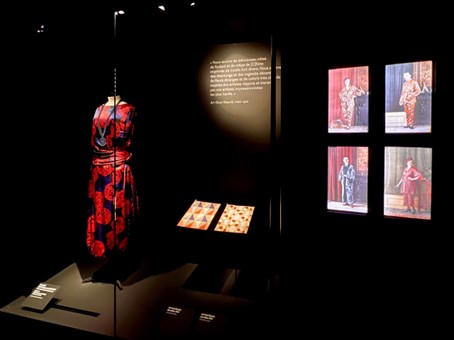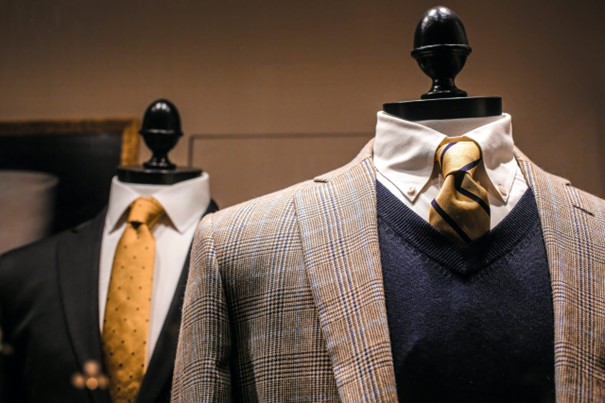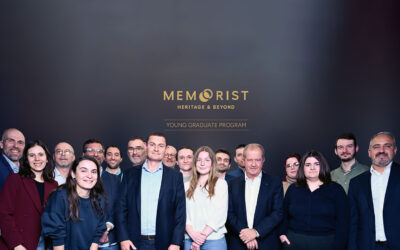An article written by our experts at TRIBVN Imaging
For several decades, the Haute Couture houses attached little importance to their archives. All the masterpieces made by the ateliers had to be worn by the most prestigious clients. The conservation of their tangible and intangible heritage was not considered essential to the running of the company.
It’s only recently that fashion designers have understood the importance of preserving their archives.
Dior Héritage, the archive department of the House of Dior, for example, has only existed since 1987. This department was created following an exhibition organised for Dior’s 40th anniversary at the Musée des Arts Décoratifs.
This change has come about thanks to the work of fashion archivists and historians, who have rediscovered and documented vintage pieces. Today, their contribution has become essential, and fashion houses have become aware of the many qualities that archives can bring to their communications. They even play a crucial role in raising their profile when they organise exhibitions about their heritage.
Public interest in the history of fashion
Undeniably, the success of fashion exhibitions and the Journées du Patrimoine (Heritage Days) demonstrates the public’s growing interest in the history of fashion and couturiers. “It’s all part of a very special context. Today, fashion is increasingly criticized for its excesses and its propensity for over-consumption. But understanding its history and know-how and affirming the role it has played in the history of France, helps to make it part of the country’s culture and is of interest to the general public,” explains Sophie Kurkdjian, fashion historian and professor at the American University in Paris. ¹

“Archives fascinate because they flirt with the memory of consumers and allow everyone to penetrate the secrets of production,” analysed the late Nathalie Rozborski, former deputy managing director of the innovation and creative consultancy NellyRodi, an innovation and design consultancy. As Côme Rémy, an expert in twentieth-century and contemporary decorative art and former head of the Conservatoire des Créations Hermès from 1993 to 1997, points out: “Culture and understanding give a history to the brand and its objects, which become more desirable at the same time as they bring customers closer to them.²
Couture houses have understood the importance of safeguarding their archives. Any item that can be linked to the brand or to the life of a couturier is of interest to them.
The Lanvin collection, for example, carefully preserves paper and photographic archives, textiles, perfumes and cosmetics, period furniture, etc.³
Heritage digitisation for future generations
These archives represent a unique and irreplaceable heritage, passed down from generation to generation. They play an essential role in the development of societies and contribute to the creation and preservation of individual and collective memory.⁴
“Every time I arrive at a house, I need to immerse myself in its past, to understand what it was through documents, images and models. I don’t do all this to pick up on a style of sleeve or collar from the past – fashions come and go, we mustn’t forget that – but to understand the philosophy, learn the vocabulary, the notes and compose the music of today. Guillaume Henry, artistic director of Patou.⁵
In addition to showing employees the importance of the work of their predecessors and tracing the company’s history, archives help to perfect a sales pitch, while reinforcing the corporate culture. They also help designers to imagine their future collections. “It’s a never-ending source of inspiration, and the archives often provide an opportunity to reinvent iconic products and brand codes,” explains Nathalie Rozborski.
Understanding the essence of the brand in order to interpret, reinvent and modernise it is of crucial importance at a time when artistic directors are in great demand throughout the year.
Interviewed on the subject by the New York Times, the late Karl Lagerfeld confided: “There would be no Chanel without the history of Chanel. But there are a lot of things that people think have existed since the beginning of the house, when in fact it was I who created them. My job is to make people believe in them; there’s no other way for a fashion house to survive.²
Fashion heritage, a know-how that the State wishes to preserve.
As this cultural heritage grows, so does the State’s commitment to it.
In 2017, a report on heritage and fashion was submitted to the Minister of Culture and Communication by Olivier Saillard, then Director of the Palais Galliera. This report confirms the major role of France and Paris in fashion design and notes the growing involvement of fashion houses in preserving their heritage and the sometimes little-known riches of regional museum collections. It nevertheless highlights the fragility of these collections due to the disparities in resources and expertise for restoring and maintaining this heritage.
Following this report, a number of measures were adopted, including the creation of a “French Fashion Heritage” label to highlight the exemplary conservation work carried out by these companies, and the creation of a fashion fund at the Centre national des arts plastiques, with the acquisition each season of five pieces by designers with the aim of organising temporary exhibitions in France and abroad, or being loaned to museums.⁶
At Hermès, we started filming craftsmen who were retiring, so that they could share their memories. Archives are time capsules“, explains Côme Rémy.²

What resources are being deployed to safeguard this heritage?
Just as fashion houses have set up sales departments in recent years, the major labels now all have heritage departments, buying up their own archives on the market.⁷
The archives department is responsible for finding items and documents relating to the history of the brand, cataloguing them with the objective of digitising them and/or restoring them if necessary, preserving their conservation and, if possible, tracing their history. “Our first task is to reconstruct as many of the collections as possible, whether Haute Couture, ready-to-wear or accessories. Priority is given, of course, to Monsieur Dior’s creations. We buy a lot of clothes, accessories and documents. There are various channels for our acquisitions, including auction rooms. We are in constant contact with the world’s leading experts. Now, private individuals are also contacting us directly to offer us clothes and accessories,” explains Soizic Pfaff, the former director of Dior Heritage.¹
Save these precious archives by digitising them
As well as preserving this heritage, digitisation facilitates the management of historical documents. It simplifies access to information, speeding up the search and retrieval process. Geographically dispersed teams can work together more easily.
Digitisation helps to strengthen the security of archives by putting in place back-ups and digital protection measures.
TRIBVN Imaging works with luxury brands to digitise iconographic documents (photographic prints, sketches, fabrics, patterns, registers).
We recently worked with iconic brand KENZO to digitise their archives:
- complete digitisation of point-of-sale advertising, press reviews, printed elements, invitations and more, from the 1970s to the present day.
- 4,000 views captured by digitising 2D and 3D documents, by digitising plan documents and packshot images so that objects can be appreciated in their entirety
- digitisation of 12,000 sketches
With our expertise in conservation, we can also handle delicate documents affected by vinegar syndrome and ensure their identification, reconditionand digitisation.

The stages of digitisation
Because we are aware of the value of the documents you entrust to us, the handling and digitisation of your archives follow rigorous processes.
- Consultancy, strategies
Before starting the process of digitising your archives, TRIBVN Imaging will direct you on the digitisation strategy for your heritage collections and on the ideal organisation of digital documents.
- Document transfers
Our qualified staff will then take care of transferring your archive stock to our digitisation centre. We ensure complete transport security and traceability.
- Document preparation
This activity involves repackaging original documents to optimise their conservation over time: acid-free sleeves, acid-free cardboard boxes, etc.
Documents can be identified in a number of ways, depending on operational constraints (entering a reference number in pencil, sticking QRCODE labels on the pockets).
- Digitisation
TRIBVN Imaging offers dematerialization services for all types of documents:
(Phototypes, degraded supports, drawings, manuscripts & binded documents). We also offer digitisation and photogrammetric 3D modelling of objects, mainly from the fields of archaeology.
- Post-processing
This involves digital processing of documents: image-by-image quality control, cropping of digitised items, negative inversion processing, digital cleaning (dust only), etc.
- Availability
We your digital assets available on the platform of your choice. Directly by transfer to your DAM, servers or other storage media.
- On-site digitisation
We can digitise on site, if your premises allow it.
We also set up databases for the collections inventory.

Dior, Louis Vuitton, Givenchy, Chanel, Chloé, Jean-Paul Gaultier and Kenzo have all placed their trust in us.
———————————
¹ Maud Gabrielson. Les tisseurs d’histoire, quand la mode soigne ses archives. https://www.lemonde.fr/m-styles/article/2021/11/29/les-tisseurs-d-histoire-quand-la-mode-soigne-ses-archives_6104069_4497319.html Le Monde. 29 November 2021
² Tanissia Issad. Have fashion archives become a business? https://fr.fashionnetwork.com/news/Les-archives-mode-sont-elles-devenues-un-business-,963582.html Fashion Network. 4 April 2018
³ Sophie Kurkdjian. Cultures and histories of fashion. https://histoiredemode.hypotheses.org/2567 Hypothèses. 2015
⁴ UNESCO. Universal Declaration on Archives. 2011
⁵ Frédéric Martin-Bernard. How does fashion cultivate its past? https://www.lesechos.fr/weekend/mode-beaute/comment-la-mode-cultive-son-passe-1241417 Les Echos, Sept. 11, 2020
⁶ Press release – Submission of Olivier Saillard’s report on heritage and fashion https://www.culture.gouv.fr/Presse/Archives-Presse/Archives-Communiques-de-presse-2012-2018/Annee-2017/Remise-du-rapport-d-Olivier-Saillard-sur-le-patrimoine-et-la-mode Ministry of Culture. 28 April 2017
⁷ Dominique Muret. Luxury: Why do fashion archives sell so much in these Covid times? https://fr.fashionnetwork.com/news/Luxe-pourquoi-les-archives-de-mode-se-vendent-autant-en-ces-temps-de-covid,1282024.html Fashion Network. 24 February 2021



